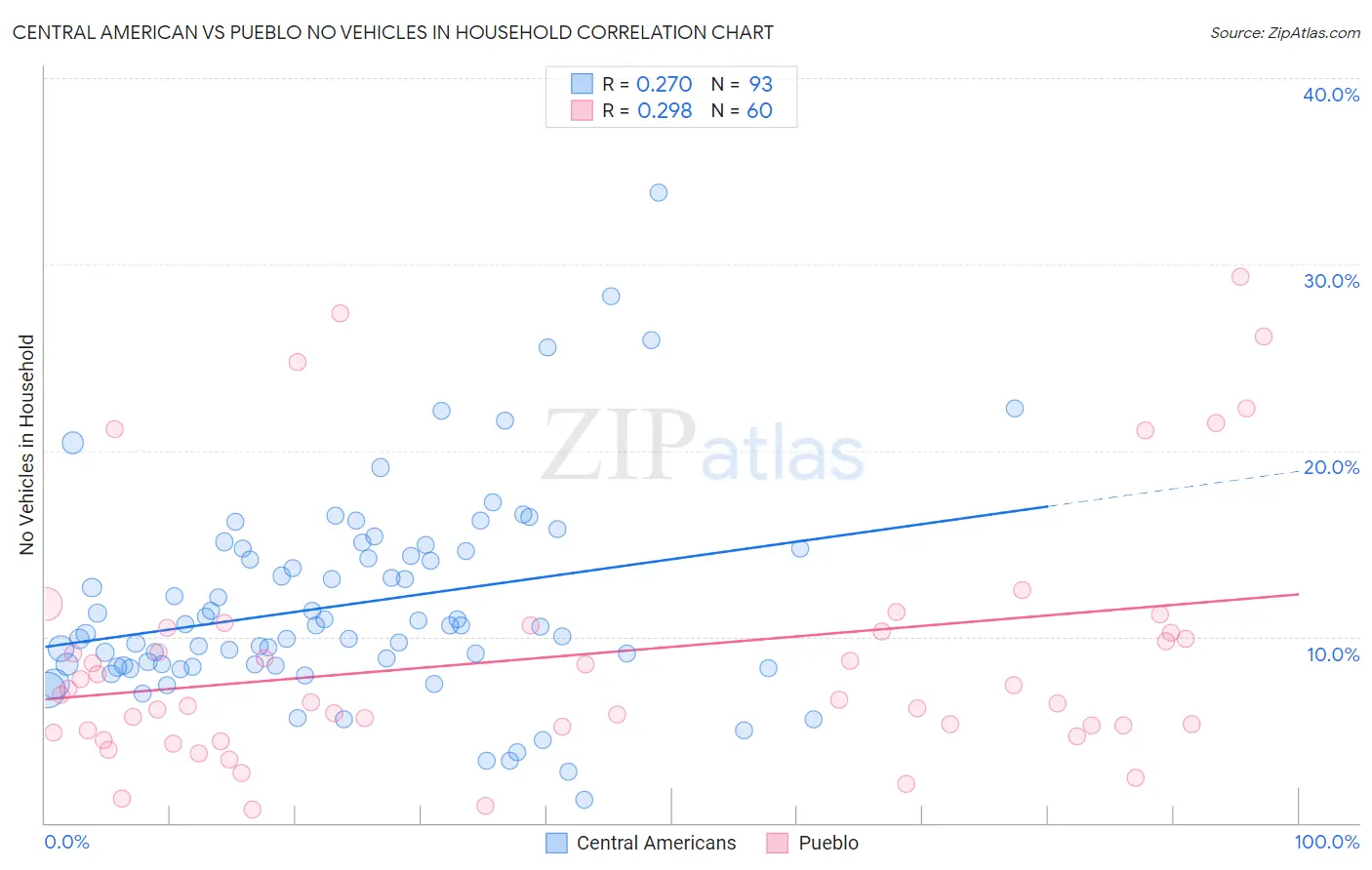Central American vs Pueblo No Vehicles in Household
COMPARE
Central American
Pueblo
No Vehicles in Household
No Vehicles in Household Comparison
Central Americans
Pueblo
10.8%
NO VEHICLES IN HOUSEHOLD
24.3/ 100
METRIC RATING
196th/ 347
METRIC RANK
10.8%
NO VEHICLES IN HOUSEHOLD
27.0/ 100
METRIC RATING
194th/ 347
METRIC RANK
Central American vs Pueblo No Vehicles in Household Correlation Chart
The statistical analysis conducted on geographies consisting of 502,389,156 people shows a weak positive correlation between the proportion of Central Americans and percentage of households with no vehicle available in the United States with a correlation coefficient (R) of 0.270 and weighted average of 10.8%. Similarly, the statistical analysis conducted on geographies consisting of 120,011,033 people shows a weak positive correlation between the proportion of Pueblo and percentage of households with no vehicle available in the United States with a correlation coefficient (R) of 0.298 and weighted average of 10.8%, a difference of 0.45%.

No Vehicles in Household Correlation Summary
| Measurement | Central American | Pueblo |
| Minimum | 1.3% | 0.72% |
| Maximum | 33.8% | 29.3% |
| Range | 32.6% | 28.6% |
| Mean | 11.8% | 9.0% |
| Median | 10.6% | 6.7% |
| Interquartile 25% (IQ1) | 8.4% | 5.1% |
| Interquartile 75% (IQ3) | 14.7% | 10.4% |
| Interquartile Range (IQR) | 6.2% | 5.3% |
| Standard Deviation (Sample) | 5.5% | 6.7% |
| Standard Deviation (Population) | 5.5% | 6.7% |
Demographics Similar to Central Americans and Pueblo by No Vehicles in Household
In terms of no vehicles in household, the demographic groups most similar to Central Americans are Shoshone (10.8%, a difference of 0.040%), Immigrants from Sweden (10.8%, a difference of 0.25%), Immigrants from Brazil (10.8%, a difference of 0.34%), Immigrants from Asia (10.9%, a difference of 0.56%), and Ukrainian (10.7%, a difference of 0.63%). Similarly, the demographic groups most similar to Pueblo are Immigrants from Brazil (10.8%, a difference of 0.11%), Ukrainian (10.7%, a difference of 0.17%), Shoshone (10.8%, a difference of 0.50%), Immigrants from Sweden (10.8%, a difference of 0.71%), and Carpatho Rusyn (10.7%, a difference of 0.82%).
| Demographics | Rating | Rank | No Vehicles in Household |
| South Americans | 41.9 /100 | #185 | Average 10.5% |
| German Russians | 40.6 /100 | #186 | Average 10.5% |
| Immigrants | Poland | 38.4 /100 | #187 | Fair 10.6% |
| Immigrants | Armenia | 37.5 /100 | #188 | Fair 10.6% |
| Immigrants | Eritrea | 36.3 /100 | #189 | Fair 10.6% |
| Immigrants | North Macedonia | 34.6 /100 | #190 | Fair 10.6% |
| Immigrants | Northern Europe | 33.1 /100 | #191 | Fair 10.7% |
| Carpatho Rusyns | 32.1 /100 | #192 | Fair 10.7% |
| Ukrainians | 28.0 /100 | #193 | Fair 10.7% |
| Pueblo | 27.0 /100 | #194 | Fair 10.8% |
| Immigrants | Brazil | 26.3 /100 | #195 | Fair 10.8% |
| Central Americans | 24.3 /100 | #196 | Fair 10.8% |
| Shoshone | 24.1 /100 | #197 | Fair 10.8% |
| Immigrants | Sweden | 22.9 /100 | #198 | Fair 10.8% |
| Immigrants | Asia | 21.3 /100 | #199 | Fair 10.9% |
| Cambodians | 19.6 /100 | #200 | Poor 10.9% |
| Immigrants | Western Europe | 19.1 /100 | #201 | Poor 10.9% |
| Romanians | 17.9 /100 | #202 | Poor 10.9% |
| Iroquois | 17.6 /100 | #203 | Poor 10.9% |
| Guatemalans | 16.1 /100 | #204 | Poor 11.0% |
| Immigrants | Chile | 15.9 /100 | #205 | Poor 11.0% |